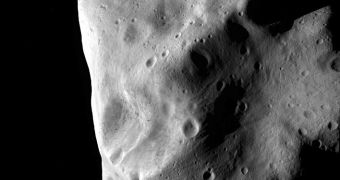On July 10, 2010, the European Space Agency's (ESA) Rosetta spacecraft carried out a flyby of asteroid (21) Lutetia, which is located in the Inner Asteroid Belt. Analysis of the data the probe sent back led astronomers to a deeper understanding of the space rock's rich and tumultuous history.
Rosetta passed within 3,170 kilometers (1,970 miles) of the asteroid, at a relative speed of about 15 kilometers (9.3 miles) per second. It is currently heading for a mid-2014 rendezvous with comet 67P/Churyumov–Gerasimenko.
The frozen body's perihelion (it's point of closest approach to Earth) is located at around 1.2458 AU. An astronomical unit is the equivalent of the mean distance between our planet and the Sun, about 93 million miles (157 million kilometers).
After launching on March 2, 2004 – aboard an Ariane V delivery system – Rosetta carried out flybys of Earth, Mars, 2867 Šteins (another IAB object), and (21) Lutetia. After it meets up with its main target, it will deploy the Philae lander on the surface of the comet.
The fact that the spacecraft was able to make detailed observations of the IAB objects is a bonus to the mission. Its instruments were able to capture a wealth of data about (21) Lutetia, including spectral readings and high-resolution images.
The space rock was imaged in multiple wavelengths, from microwave to ultraviolet, allowing scientists an unprecedented insight into how the asteroid appeared and evolved. The Optical, Spectroscopic and Infrared Remote Imaging System (OSIRIS) instrument was essential for these studies.
It used both its narrow-angle camera (NAC) and wide-angle camera (WAC) to collect some 462 high-resolution images of the asteroid's northern hemisphere, which was illuminated at that time. 0
“The images collected by Rosetta during the flyby have uncovered, for the first time, the wide variety of craters and other geological features that scar the surface of Lutetia,” Rita Schulz explains.
“Scientists have explored this rich pool of data thoroughly in order to characterize many of Lutetia's properties, from its surface morphology and composition to its shape and internal structure, revealing its underlying geological history,” adds the expert, an ESA Rosetta project scientist.
Details of the investigation appear in 21 research papers, all of which were published in a special issue of the esteemed journal Planetary and Space Science, Astrobiology Magazine reports.
“The data collected during Rosetta's flyby of Lutetia have provided us with a brand new view on this intriguing object. I expect that scientists will continue to investigate these unique and extraordinary data for years to come, pushing forward our knowledge about this asteroid and its origin, and revealing new details about the Solar System's past history,” Schulz concludes.

 14 DAY TRIAL //
14 DAY TRIAL //